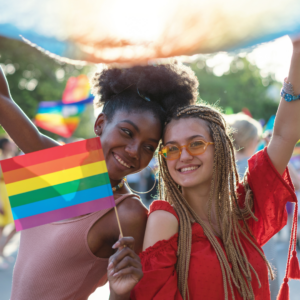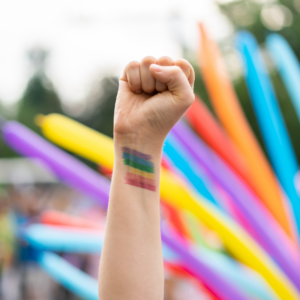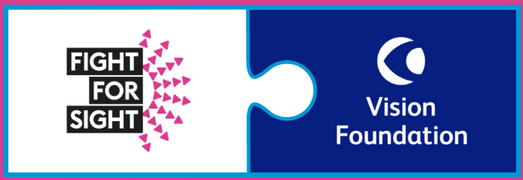
Pride Month is celebrated in June every year as a tribute to the trailblazers involved in the Stonewall Riots. Whether your Pride Month includes hosting or attending events, sharing information online, or connecting with other community members, it’s important to make your content accessible for LGBTQIA+ disabled people. We’ve put together some top accessibility tips to help you make everyone feel included this Pride Month!
1) Use image and video descriptions for digital content
Alt (alternative) text and image/video descriptions allow blind and partially sighted people to get the full context of photos and graphics online. You can add these to your social media posts at the draft stage, or add them to the caption with the preface “Image/Video description:”. Use this handy guide for practical tips on adding Alt Text to different social media platforms.
Here are some examples of how photos can be described:

 The photo on the left could be described as: “Two women posing closely at a Pride parade. The woman on left is black, with curly hair worn in a loose bun. She i wearing a dusty pink vest and waving a rainbow pride flag. The second woman has a light-brown skin tone and wears her hair in long brown-blonde brains. She is wearing pink tinted sunglasses and a flowy red dress. They are holding a pride flag above their heads and smiling widely.”
The photo on the left could be described as: “Two women posing closely at a Pride parade. The woman on left is black, with curly hair worn in a loose bun. She i wearing a dusty pink vest and waving a rainbow pride flag. The second woman has a light-brown skin tone and wears her hair in long brown-blonde brains. She is wearing pink tinted sunglasses and a flowy red dress. They are holding a pride flag above their heads and smiling widely.”
The photo on the right could be described as: “The raised fist of a white person against a background of rainbow-coloured tube-shaped balloons. On their wrist, they have the colours of the pride flag painted on”
2) Add captions and audio description to videos
Adding captions to transcribe dialogue or narration of videos makes it more inclusive to people who are deaf or hard of hearing. These can be added automatically on various platforms, but be sure to check the automated captions for accuracy as sometimes accents can be transcribed inaccurately by the AI. Uploading an audio-described version of videos is a great way to showcase visual elements of your content to blind and partially sighted viewers.
3) Consider colour contrast when making infographics
Pride Month is a great opportunity to share powerful infographics to educate audiences or raise awareness of issues affecting the community. Be mindful of how the colours you choose could affect readers with a vision impairment. A great way to check the contrast of your colours is to use an image colour picker to pull out the HEX code of your colours and then input it into the WebAIM contrast checker to see if it passes the Web Content Accessibility Guidelines.
4) Have a Word alternative to PDF resources
PDFs can often be difficult for screen-reader users to decipher due to nature of the document or the shape, image and text layouts. Offering a plain-text version of resources makes it easy for blind and partially sighted users to access the document, adjust the font and size and read its content. You can utilise the “Styles” tab in Word to assign headings to different sections to make it even easier to navigate the document.
5) Use CamelCase when writing hashtags
Hashtagging helps users reach their audiences and has become a core feature on many social media platforms. However, when writing long hashtags using all lower-case letters, screen-reading software cannot always decipher the phrase. To avoid this we use CamelCase, the process of capitalising the first letter of each word. For example tagging #Yayitspridemonth would be read as one word and wouldn’t make much sense, but #YayItsPrideMonth would convey the meaning perfectly!
Time to share your content with Pride!
Thank you for taking the time to learn more about accessible content creation. From everyone at Fight for Sight and Vision Foundation, we wish you a brilliant Pride Month! If you want to know more about supporting disabled people in the LGBTQIA+ community, Stonewall have shared a great blog on ways to be an ally to the disabled community.

